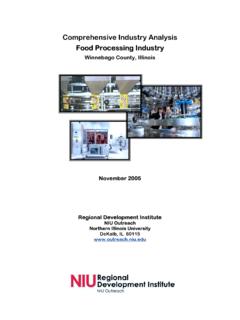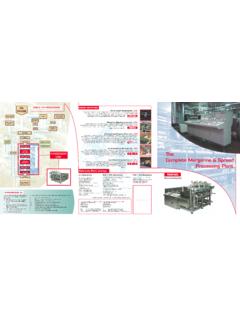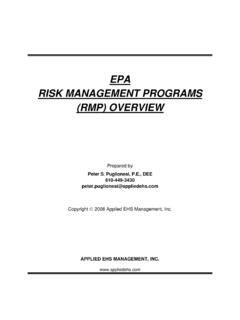Transcription of The South African Food Processing Industry - SANEC
1 The South African FoodProcessing IndustryJuly 2011 Embassy of the Kingdom of the NetherlandsPretoria, South AfricaJuly 2011 This report is compiled by D A Harcourt ) forThe Agriculture, Nature and food Quality DepartmentEmbassy of the Kingdom of the Netherlands210 Queen Wilhelmina AvenueNew Muckleneuk 0181 Pretoria South AfricaTel: +27 12 425 4570 Fax: +27 12 425 4571 Email: South African food Processing Industry1 ForewordThis report was written to give a selected overview of the South African food Processing Industry as a generalresource but in particular serve as an input to a planned Dutch Delegation of business persons to South report is not a comprehensive analysis of the whole Industry as this is too large a topic. It thereforefocuses on information relevant to the planned delegation, considering only parts of three food chains (dried &juiced fruit, processed meat and dairy).
2 The first section, which introduces South Africa as a country, is the standard introduction to agricultural sectorreports used by Theof the Kingdom of Netherlands Embassy in some of the information is not the most recent available, the introduction still gives a good view of theissues described and cannot be updated within the context of the current report. Only minor changes, neitheraffecting the data nor the essence of the section, were made to the by D A Harcourt ) for The Office of the Agricultural Counselorof the Embassy of the Kingdom of the NetherlandsJuly 2011 Pretoria, South AfricaOffice of the Agricultural Counselor2 Table of to the information (CIA, 2009) data (CIA, 2009) information (CIA, 2009) South African additional Land Decrease in numbers of white Electricity Processing Export/import Africa's industrial food food processors and environmental Equipment Packaging Ingredients and raw Process Human resources in the food Processing Establishing a Market information224.
3 Retail Fairtrade market24 The South African food Processing consumer markets different Processing fruit Dried Fruit meat & value Products and Regulatory Opportunity43 Appendix 1 - references44 Appendix 2 - cont acts45 The South African food Processing Industry5. Consumer25,1 URL last visited 2-7-2010 CIA Factbook South Africa41. Introduction to the General Economical informationSouth Africa is officially called the Republic of South AfricaRSA The current head of the state is President JacobZuma. The Capital of South Africa is PretoriaSouth Africa has nine provinces: Western CapeNorthern CapeEastern CapeKwaZulu NatalFree stateNorth westGautengMpumalanga and LimpopoGeographic information (CIA, 2009)Surface:1,219,912 km2 Neighbour countries:Botswana Lesotho Mozambique NamibiaSwaziland ZimbabweCoastline:2798 kmSurface:Plateau in the interior, along the edge rugged hills and narrowcoastal planeLowest point:Sea levelHighest point:Mount NjesuthimNatural resources:Gold, coal, chrome, antimonium, iron oremanganese, nickel, phosphates, tin, uranium, diamonds, platinum,copper, vanadium, salt, natural.
4 General temperate climate with 9 different climate zones fromsubtropical to desert climate $ billionGDP per capitaUS $ 10,100 Agricultural contribution to %Total exportsUS $ billion ( to the NetherlandsTotal importsUS $ billionUnemployment rate24%Population below poverty line50%Number of farmersEstimated of theAgricultural sectorEstimated total of 1,5 million peopleMinimal agricultural wagesR per monthAverage agricultural incomeEstimated R ()..1,2, 3, 4-,5, 6-, 7, 89.,,, ,,(3,408),)(2009) Demographic data (CIA, 2009)According to the latest estimate of 2009 the country has 49,052,489 residents, of which million areZimbabweans. The population shrinks every year, due to mainly AIDS. South Africa is a multi ethnic andmulticultural country The composition of the population is as follows blackwhitecolouredandindiansThe total employment within South Africa ismillion individuals inMillion individuals areemployed in agriculture hunting forestry and fishingindividuals are employed in skilled agricultureAge distribution:0-14 = (6,603,220 male, 6,525,810 female)15-64 = 65% (13,955,950 male, 14,766,843 female)65> = (905,870 male, 1,429,944 female)Birth births per 1000 persons (estimates from 2006)Death rate:22 deaths per 1000 personsInfant deaths per 1000 living birthLife estimation at birth:Total: yearsMale: yearsFemale: yearFertility case:2,2 births per woman.
5 ;;79%,; 10%,; 8%; 3%.172007. ,,, 340, 1. South Africa s 9 provinces'The South African food Processing Agricultural information (CIA, 2009)Suitable agriculture landTotal surface of land122,320,100 ha100%Total South African farm land100,665,792 arable land16,737,672 irrigated1,354,128 land83,928,320 conservation11,785,999 ,433,964 ,434,345 to other African countries, South Africa s agricultural sector is not dominated by subsistencecommunal farming, with most farms being large commercial, albeit family-owned, enterprises. The country isalmost self-reliant and exports massive amounts of agricultural produce. Many other southern Africancountries rely on South Africa for their food importsThe average annual rainfall, illustrated in Figure 2 below shows a rapid decline from eastmm to westmm More thanpercent of the country receives less thanmm per annum, and approximately onefifth of the country receives less than 200 mm per annum.
6 The southern coastal region of the Western CapeProvince receives rainfall throughout the year while the rest of the province gets its rainfall in winter Theremainder of the country is classified as summer rainfall area FAO'.,(> 800)(<200).60600,.(, 2005) .RAINFALLF igure 2. South Africa s average annual rainfall'Source:FAO Corporate Document RepositoryThe South African food Processing Industry6 CROPSDue to the country's varied climate, many different crops are grown. The Western Cape Province has the mostvaried and prolific agricultural sector Wine has become a massive export product with South Africa now beingthe th largest producer worldwide Deciduous fruit is also of major importance with grapes apples cherriespears peaches citrus and other fruit being exported in great quantities mostly to Europe Heavy wheatcultivation also occurs in the region, along with major wheat growing areas in the Highveld of Mpumalangaand the Free State The Free State is the leading producer of South Africa s staple maizeAs shown in Figure 3 below, the vast inland regions of the Karoo provide ideal conditions for livestock farming,especially sheep farming (for wool and mutton).
7 ,5.,,,,,,,..':.Cattle farming is more popular amongst the indigenouspeople and flourishes more in the more well-watered eastern areas of South Africa Ostrich farming is popularin the Oudtshoorn area of the Western Cape along with intensive dairy farming on the Garden Route on thesouth coast Sugarcane farming is a mainstay on the KwaZulu-Natal coast with subtropical fruits such asmangos lychees papaya bananas and melons being extensively cultivated in KwaZulu-Natal Limpopo andMpumalanga Lowveld areas Pineapples are cultivated in the Eastern Cape around East London Many gamefarms specializing in South African wild antelopes are also gaining in importance and are found mainly in thenorth and east of South AfricaFAO Corporate Document RepositoryDespite attempts by government to reform the distribution of land, historically mostly held by whites, theseefforts have not yet translated into growth in the agricultural sector, which continues to lag behind or evendecline in relation to the rest of the economy.
8 This may also be due to the fact that indigenous people aremostly subsistence farmers and that anti-competitive practices like agricultural subsidies in developedcountries and climate change are curtailing the sector s Africa is no doubt the continent s champion when it comes to policy and legislation. The agriculturalsector is regulated by the National Department of Agriculture, Forestry and Fisheries (DAFF). The DAFF svision states a united and prosperous agricultural sector. The agriculture is regulated through several acts- Animal and aqua production- Animal health- Bio safety- food and Veterinary Services- food Safety and Quality Assurance- Genetic resources- Land Use and Soil.,.,,,,,,..:''';Figure 3. Agricultural regions of South LegislationThe South African food Processing Industry7- Marketing- Plant Health- Plant Production- Research and Technology Development- Veterinary servicesImport and exports are regulated by the DAFF as well, but legislation of the destination countries applies aswell.
9 Characteristics of the South African legislation is that National Acts can be customized by ProvincialGovernment, but they are only able to make legislation important legislation is the Competition act founded by the Government of South Africa in 1998, theDepartment of Trade and Industry drafted the recent version in 1997. The Competition Commission isresponsible for implementing the Competition act. The Competition act ensures equal opportunities for allenterprises in the South African Africa is the country with the largest number of HIV infected in the world. The country s Department ofHealth estimates that of adults were living with HIV in 2006. 55% of all South Africans infected withHIV reside in the KwaZulu-Natal and Gauteng provinces. Rising death rates lowered life expectancy at birthfrom 59 years in 1990 to 43,8 years in 2009 for males and from 67 years in 1990 to 42,7 years in 2009 prevalence among pregnant women is highest in the populous KwaZulu-Natal provinceand lowestin the Western CapeNorthern Capeand Limpopoprovinces In the five other provincesEastern Cape Free State Gauteng Mpumalanga and North West at leastof women attending antenatalclinics intested HIV latest HIV data collected at antenatal clinics suggest that HIV infection levels might be levelling off, withHIV prevalence in pregnant women at 30% in 2005, 29% in 2006, and 28% in 2007.
10 The decrease in thepercentage of young pregnant women24 years) found to be infected with HIV also suggests a possibledecline in the annual number of new has a tremendous impact on all sectors of the South Africa's economy. This includes microeconomicand macroeconomic perspectives A study on its economic impact singles out the following effects A decline in total labour supply A decline in labour productivity resulting from HIV/AIDS-related morbidity Increased production costs, prices, and a decline in aggregate demand, savings and investment Increased household expenditure Increased government expenditureCrime is a prominent issue in South Africa South Africa has a high rate of murders assaults rapes and othercrimes compared to most countries A survey for the period 1998 2000 compiled by the United Nations Officeon Drugs and Crime ranked South Africa second for assault and murder per capita and first for rapes percapita.







